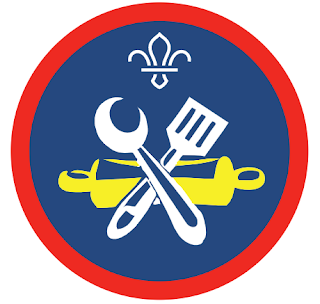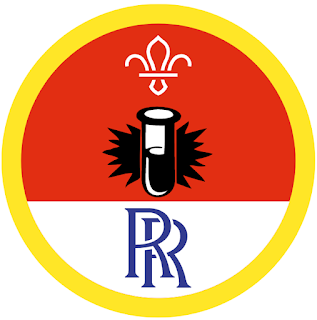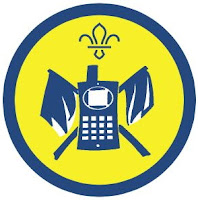Scouts: Chef Activity Badge
How to earn your badge:
Plan a menu for a weekend event for between four and six people.
Include the quantities you’ll need and any dietary needs of the group for cultural, religious or medical reasons.Cut out the cards from the ‘Matching cards’ sheet and place these face down. Put all the food items on the left and all the portion sizes on the right mix each pile up.Write the portion sizes below somewhere that you can see it. Palm – Meat, fish & beans, Fist – Fruit & Veg, Cupped Hand – Starchy carbohydrates, Thumb – Cheese, peanut butter, Thumbnail – Oils, butter, saucesYou are looking at food portions and how to know if you’re eating too much or not enough of a certain food group. Take five minutes to look at the sheet in their groups and ask for help from your parent/carer if anything on the sheet is not clear. Remember that all the face down cards on the left are food and all the cards on the right are portion sizes. You should try and match the food to the correct portion size, as shown on their Handy guides. Portion sizes should apply to all meals across the day.Next, using the ‘Pick your portions and plan your meal’ sheet try to plan all the meals for a particular day, choosing a balanced mix of foods and drinks in the correct portion sizes. Use your ‘Handy guide’ to help. Take around fifteen minutes to plan your menu. Fill out the ‘Pick your portions’ part first to get all the food you need, before filling out the meal planner.You have looked at portion sizes and made some meal plans. Have you ever thought about their portion sizes before? What meals of the day tend to have larger or smaller portions? What might happen if you eat too much of one thing? Have you seen anything in their kitchen at home that might be used to control portion sizes (e.g. scales, different sized containers)? How might you amend your menu if someone you were cooking for had an allergy, was vegetarian/vegan or had faith or cultural food choices they needed to be considered?Show how and where to shop for the food and the best way to transport it.
Make a mind map of all the places you could go to shop for your food, how will you get to the shops and how you might be able to transport your food to get it home. How can you make your choices more environmental, what if you could only use small businesses and had no car?Show how to store food properly, hygienically and in ways that prevent food poisoning.
Explain what you might need to consider if you’re using an indoor kitchen or a camp kitchen.What do we mean when we discuss food ‘use by’ and ‘best before’ dates? A ‘use by’ date shows the time food needs to be eaten by. When this has passed, leftover food should be thrown away, as eating it could make you sick. A ‘best before’ date shows the recommended time to eat food. When this has passed, food may still be eaten, but won’t be as fresh.Cut out the foods from the ‘Food storage’ sheet and mix them up, then take each food item and place it in the correct storage location. This is the place that you think will be best to store that item of food, to keep it fresh, tasty and safe to eat. When all of the foods have been placed with a storage method, check them against the complete ‘Food storage’ sheet and read out the correct solutions. Read the explanations given too.Take a copy of the ‘Shopping list and meal planner.' On the ‘Shopping list’ are a list of foods and their quantities, and when they need to be used by. On the ‘Meal planner,’ you should plan out five evening meals for two people. You need to make sure that none of the food goes off before it can be used across the five days, even items they don’t use. At the same time, you should try and make sure each meal is healthy and balanced. Also, bear in mind that other things they need to cook, such as appliances, utensils, oil, condiments, herbs and spices, are all available and don’t need to be factored into this. Discuss with your parent or carer what they think of your menu.A large part of being independent is being sure that you have enough food when you need it. To live healthily, we need to eat the right foods, so you have to strike a balance between using what’s available, selecting what you need to eat and doing so before it goes bad. Which of these is most important? Hard to source foods will probably be expensive, while eating out of date food could make you very ill. Prioritise having something fresh and wholesome ready to go for each meal, before thinking about it’s health benefits or cost.- Cook and serve at least one of the meals from your menu.The meal must be at least two courses and prepared in a kitchen. You should prepare and cook vegetables as part of the menu. Remember, to discus with your parent/carer how much supervision you need for cooking your meal. This will vary depending on your age and how much experience you already have with cooking. If you are not sure how to complete a task make sure to ask. Talk to the people you’re cooking for about the menu.Ask your parent/carer to find or shop for the ingredients you need.Once your parent or carer has had time to shop for the ingredients needed, get ready to cook by tying up your hair, putting on an apron, and washing your hands.Now may be a good time to check you remember about being clean and safe in the kitchen. Make sure to wipe down the surface with disinfectant spray before you start cooking.Everyone should follow their 2 recipes to create a delicious meal. Remember that ovens take time to cool, so they can still be dangerous even if they’re switched off.This activity was a chance for you to practice the skills and knowledge you have while learning new ones and making a tasty feast. As everyone enjoys their food, you can talk about the skills you used when cooking. Did anyone try something new? Some Scouts may not have opened tins, grated, or mashed things before. Did anyone taste a new food? It was important to use the skills you already had, including being safe and clean in the kitchen, while learning new ones.This activity was also a chance to be independent. You had to make your own decisions, for example, adjusting the taste when you made a dressing, or deciding what vegetables to add to their dish. Did anyone have a chance to try something other people normally do for them? You may think about chopping vegetables or using a grater. It’s great to achieve things for yourself – well done!
Safety
- Food
- Check for allergies before you begin. Make sure you have suitable areas for storing and preparing food and avoid cross contamination of different foods.
- Cooking
- Teach young people how to use cooking equipment safely. Supervise them appropriately throughout. Make sure it’s safe to use and follow manufacturers’ guidelines for use.
- Sharp objects
- Teach young people how to use sharp objects safely. Supervise them appropriately throughout. Store all sharp objects securely, out of the reach of young people.
All activities must be safely managed. Demonstrate the best way to clear up afterwards.
Clearing up should include washing up utensils, pots and pans, disposing of rubbish and leftover food in a way that prevents vermin or disease.You should make a photographic photo journal of how the kitchen looked after you finished cooking and the different tasks needed to return your kitchen to a pristine condition! What tasks were tricky? Did you correctly recycle rubbish and vegetable peelings? What was the best/worst parts of preparing the meal and clearing up afterwards.





